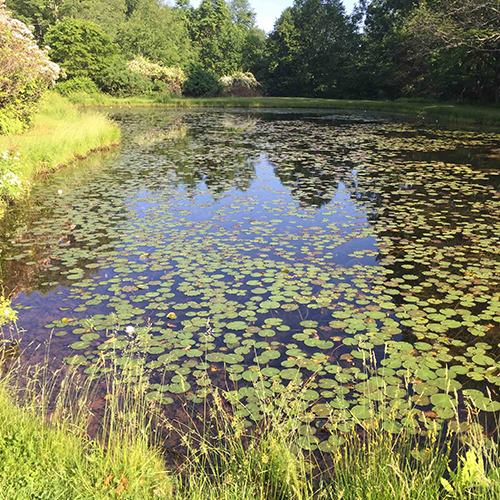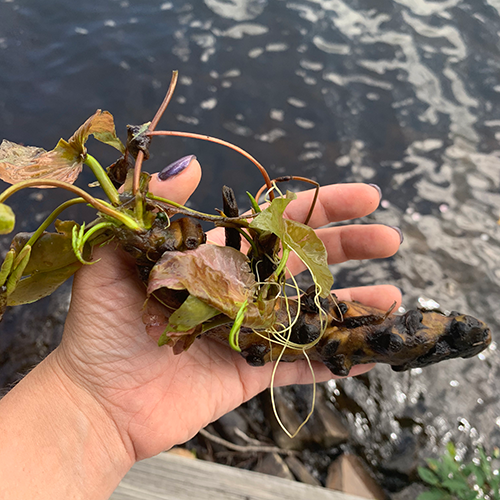Water Lily - pond plant with flowers
Nymphaea or hardy water lily is one of the most common pond plants. The water lily is classified as an emergent plant although its root is often far below the pond water surface.
It consists of a network of rhizomes that product long stems. From the stem comes large round leaves that float at the surface of the water. Lily pads are 6-12" in diameter. As the root rhizomes extend, more lily pads emerge. In areas with nutrient rich pond bottoms, the rhizomes and lily pads begin to spread across a pond quickly.
The stems also produce flowers that can be white, yellow, and pink. Flowers often bloom from June until September. Each flower produced lives at the surface for 3 to 5 days and then dies back. While at the surface the flower opens during the day and closes at night.
There are other varieties of tropical water lilies that are not native to the United States. These species are easy to distinguish because their lily pads have spiked edges. Other similar pond weeds include water shield and spatterdock, which both produce a floating pad.
The water lily nymphaea is commonly found because pond owners plant these for fish habitat, water quality, or simply for the beautiful flowers they produce. It is easy to transplant lilies from one pond to another by breaking a portion of the rhizome and replanting in a shallow trench.


How do lily pads spread?
They spread by their rhizome (root system) and the seeds that they produce. An example of a water lily rhizome is pictured above. One rhizome can produce 15 feet of surface cover in just 5 years.
Water lilies can spread rapidly through a pond.The network of rhizomes can make it difficult to manage.
How deep can water lilies grow
They can grow easily in 6-7 feet of water. The depth that lilies can grow varies based on water clarity.
Are lily pads good for ponds
Water lilies create habitat for largemouth bass and other game fish. Lily pads also create an area for young fish to live. Areas covered in lilies are less likely to have algae blooms because the surface coverage blocks sunlight needed for algae to grow.
If left unmanaged lilies can also have detrimental effects. Extensive lily cover can reduce the exchange of oxygen at the water surface. This oxygen is vital to all aquatic life. Water lilies also attract mosquitoes and aphids.
If a pond or lake owner seeks the benefits of lily pads but doesn't want the maintenance, artificial water lilies can be installed to replace live aquatic plants. Check out our artificial water lilies and other artificial fish habitats.
Natural way to get rid of lily pads
A pond rake or cutter can be used for lily pad removal. This is a short-term management option because lilies grow from rooted rhizomes in the pond bottom soil. These rhizomes will quickly produce new shoots if left in the pond.
Water lilies are not a preferred food of grass carp.
How to kill lily pads :
For early season control apply Navigate granular aquatic herbicide. The active ingredient in Navigate is 2-4D which is an effective systemic herbicide. Granules sink to the bottom and kill nymphaea at the roots. Results are noticed in 7-10 days after application.
Glyphosate 5.4 is a liquid aquatic herbicide that will work on lily pads that have reached the surface. Spray glyphosate mixed with surfactant directly on lily pads to kill vegetation to the roots.
Clearcast is a liquid aquatic herbicide for lily pads. The active ingredient in Clearcast is imazamox which is a systemic herbicide that kills to the root of the plant.
This treatment is tank mixed and sprayed on mature vegetation that is growing at the water surface. All lily pads must be sprayed for good results. Results are noticed in 7-10 days after application.
To enhance treatment effectiveness and reduce waste from dead vegetation, mix Clearcast with Pondzilla treatment enhancer.
Lily Pad Control
Next Steps After Herbicide Treatment
Once water lilies have been sprayed, take these proactive steps to keep the pond clean and weed free. Apply pond dye to reduce sunlight from reaching the bottom of the pond where new growth begins. Use pond dye monthly for best results. Use Muck Remover pellets to break down decaying lilies and other muck in the pond.
Need help identifying your POND WEED or How Much Treatment To Use?
